Strategic Analysis: Sainsbury's Business Strategy and Recommendations
VerifiedAdded on 2023/04/22
|19
|4766
|177
Report
AI Summary
This strategic analysis report critically examines Sainsbury's, a leading UK retailer, evaluating its business strategies. The report analyzes the external and internal environments using tools like PESTLE and Porter's Five Forces to identify threats and opportunities. A resource-based view using VRIO analysis assesses Sainsbury's strategic capabilities, highlighting brand value as a source of sustainable competitive advantage. The strategic position analysis, employing Porter's Generic Strategies and the Strategy Clock, indicates a differentiation strategy, though the report recommends incorporating cost leadership to address economic instability. Strategic fit is considered, and warfare perspectives are offered to understand the competitive landscape. The report concludes with recommendations for ensuring Sainsbury's future sustainability and competitive edge in the dynamic retail market. Desklib provides access to similar solved assignments and resources for students.
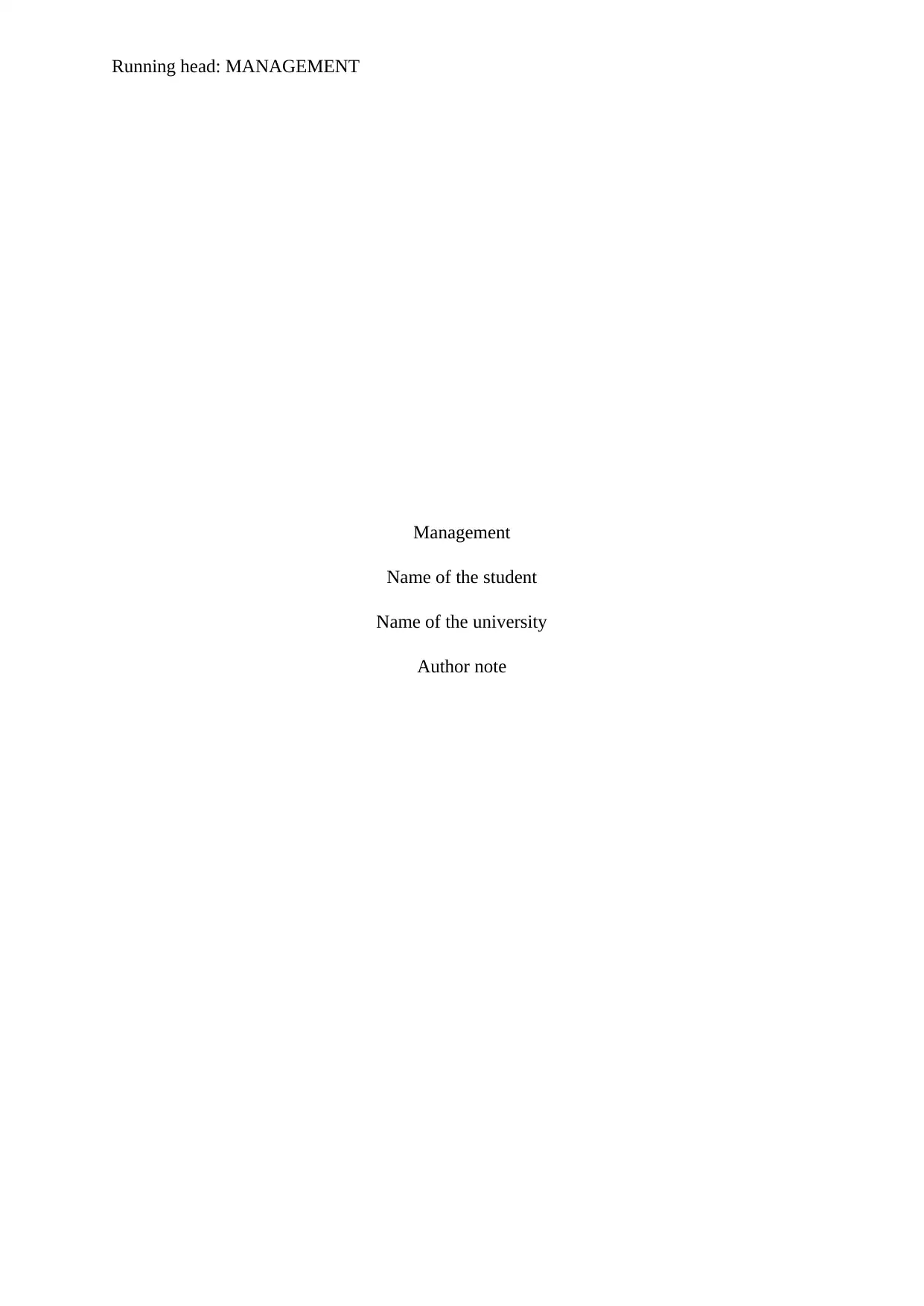
Running head: MANAGEMENT
Management
Name of the student
Name of the university
Author note
Management
Name of the student
Name of the university
Author note
Paraphrase This Document
Need a fresh take? Get an instant paraphrase of this document with our AI Paraphraser
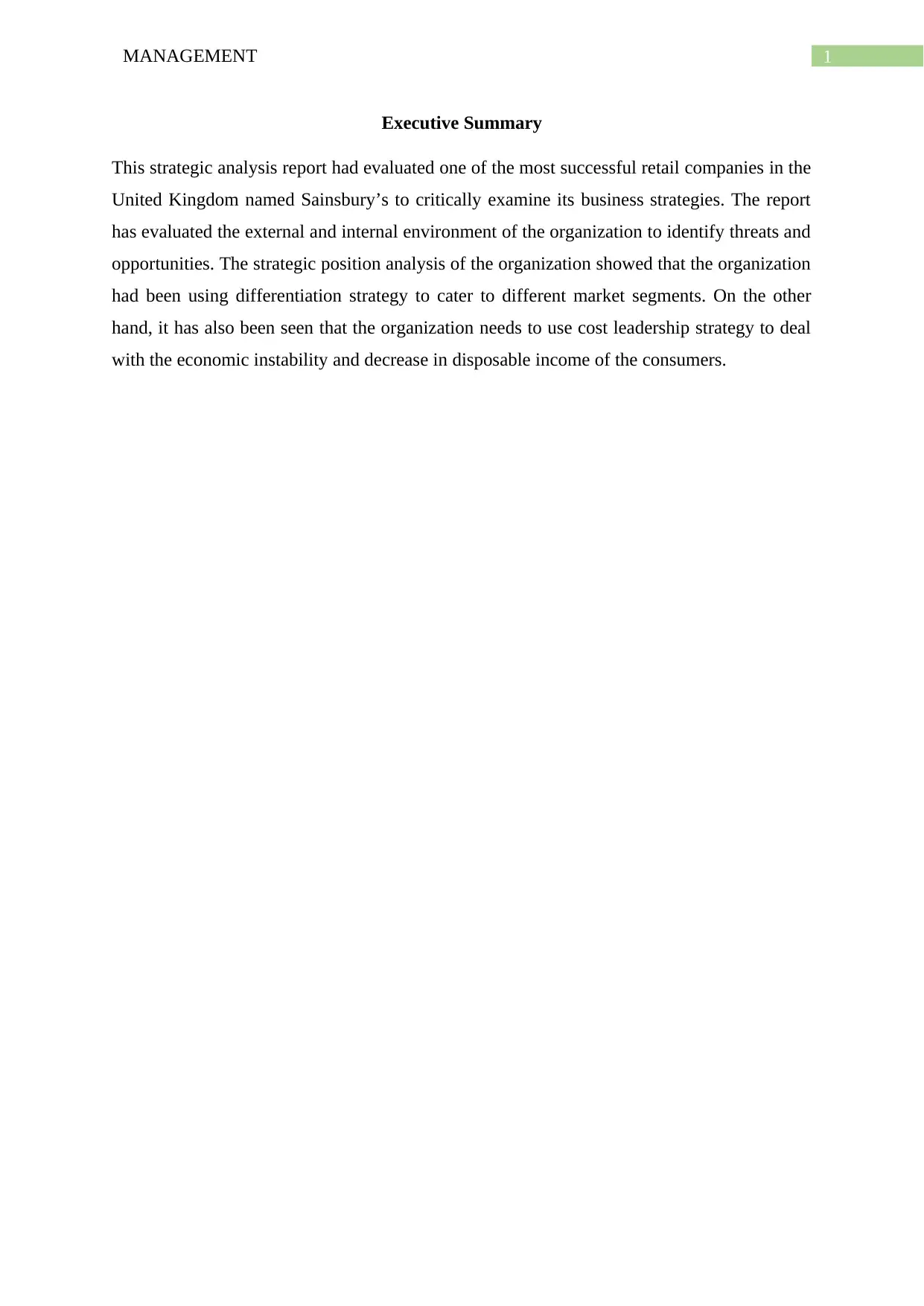
1MANAGEMENT
Executive Summary
This strategic analysis report had evaluated one of the most successful retail companies in the
United Kingdom named Sainsbury’s to critically examine its business strategies. The report
has evaluated the external and internal environment of the organization to identify threats and
opportunities. The strategic position analysis of the organization showed that the organization
had been using differentiation strategy to cater to different market segments. On the other
hand, it has also been seen that the organization needs to use cost leadership strategy to deal
with the economic instability and decrease in disposable income of the consumers.
Executive Summary
This strategic analysis report had evaluated one of the most successful retail companies in the
United Kingdom named Sainsbury’s to critically examine its business strategies. The report
has evaluated the external and internal environment of the organization to identify threats and
opportunities. The strategic position analysis of the organization showed that the organization
had been using differentiation strategy to cater to different market segments. On the other
hand, it has also been seen that the organization needs to use cost leadership strategy to deal
with the economic instability and decrease in disposable income of the consumers.
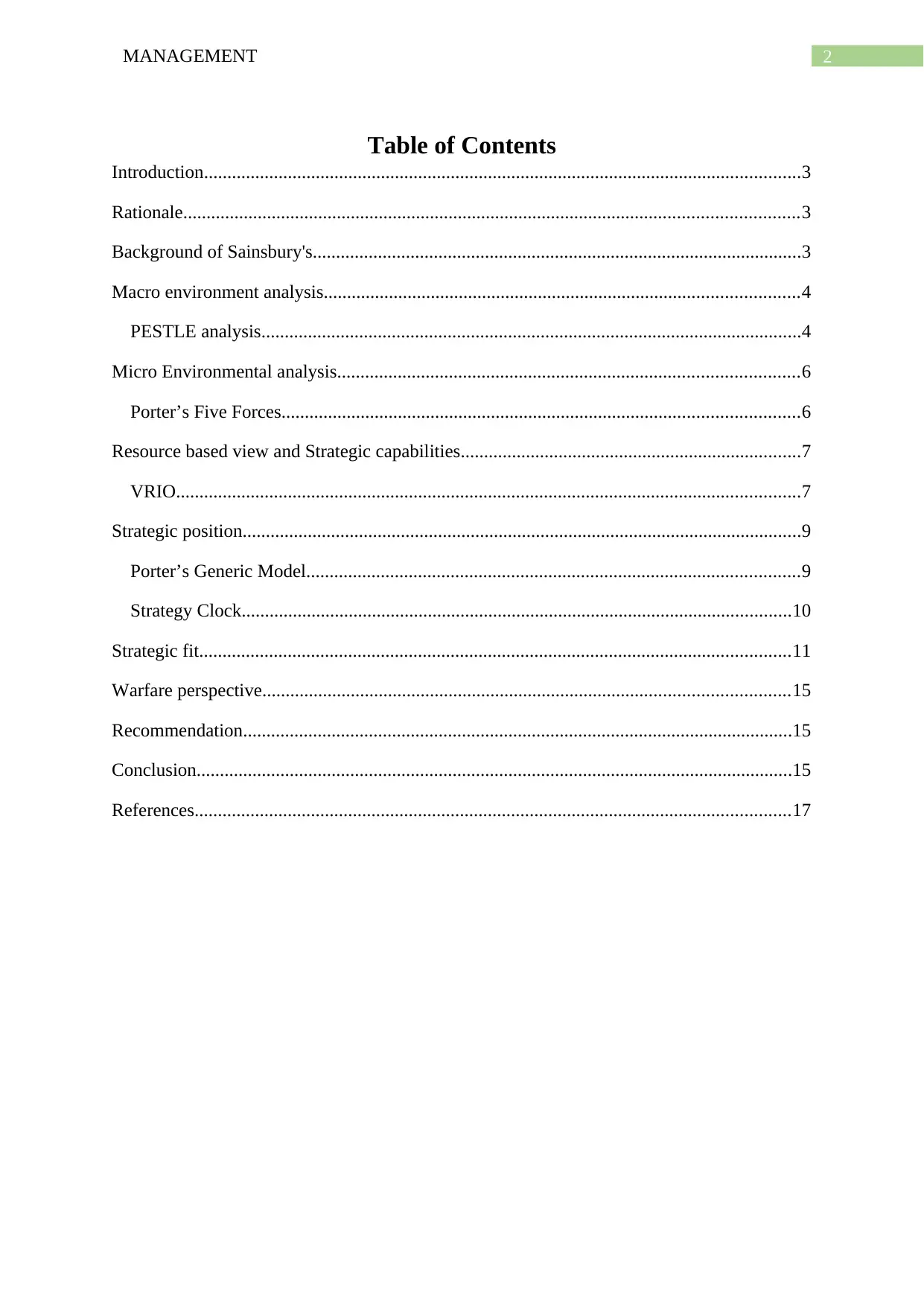
2MANAGEMENT
Table of Contents
Introduction................................................................................................................................3
Rationale....................................................................................................................................3
Background of Sainsbury's.........................................................................................................3
Macro environment analysis......................................................................................................4
PESTLE analysis....................................................................................................................4
Micro Environmental analysis...................................................................................................6
Porter’s Five Forces...............................................................................................................6
Resource based view and Strategic capabilities.........................................................................7
VRIO......................................................................................................................................7
Strategic position........................................................................................................................9
Porter’s Generic Model..........................................................................................................9
Strategy Clock......................................................................................................................10
Strategic fit...............................................................................................................................11
Warfare perspective.................................................................................................................15
Recommendation......................................................................................................................15
Conclusion................................................................................................................................15
References................................................................................................................................17
Table of Contents
Introduction................................................................................................................................3
Rationale....................................................................................................................................3
Background of Sainsbury's.........................................................................................................3
Macro environment analysis......................................................................................................4
PESTLE analysis....................................................................................................................4
Micro Environmental analysis...................................................................................................6
Porter’s Five Forces...............................................................................................................6
Resource based view and Strategic capabilities.........................................................................7
VRIO......................................................................................................................................7
Strategic position........................................................................................................................9
Porter’s Generic Model..........................................................................................................9
Strategy Clock......................................................................................................................10
Strategic fit...............................................................................................................................11
Warfare perspective.................................................................................................................15
Recommendation......................................................................................................................15
Conclusion................................................................................................................................15
References................................................................................................................................17
⊘ This is a preview!⊘
Do you want full access?
Subscribe today to unlock all pages.

Trusted by 1+ million students worldwide
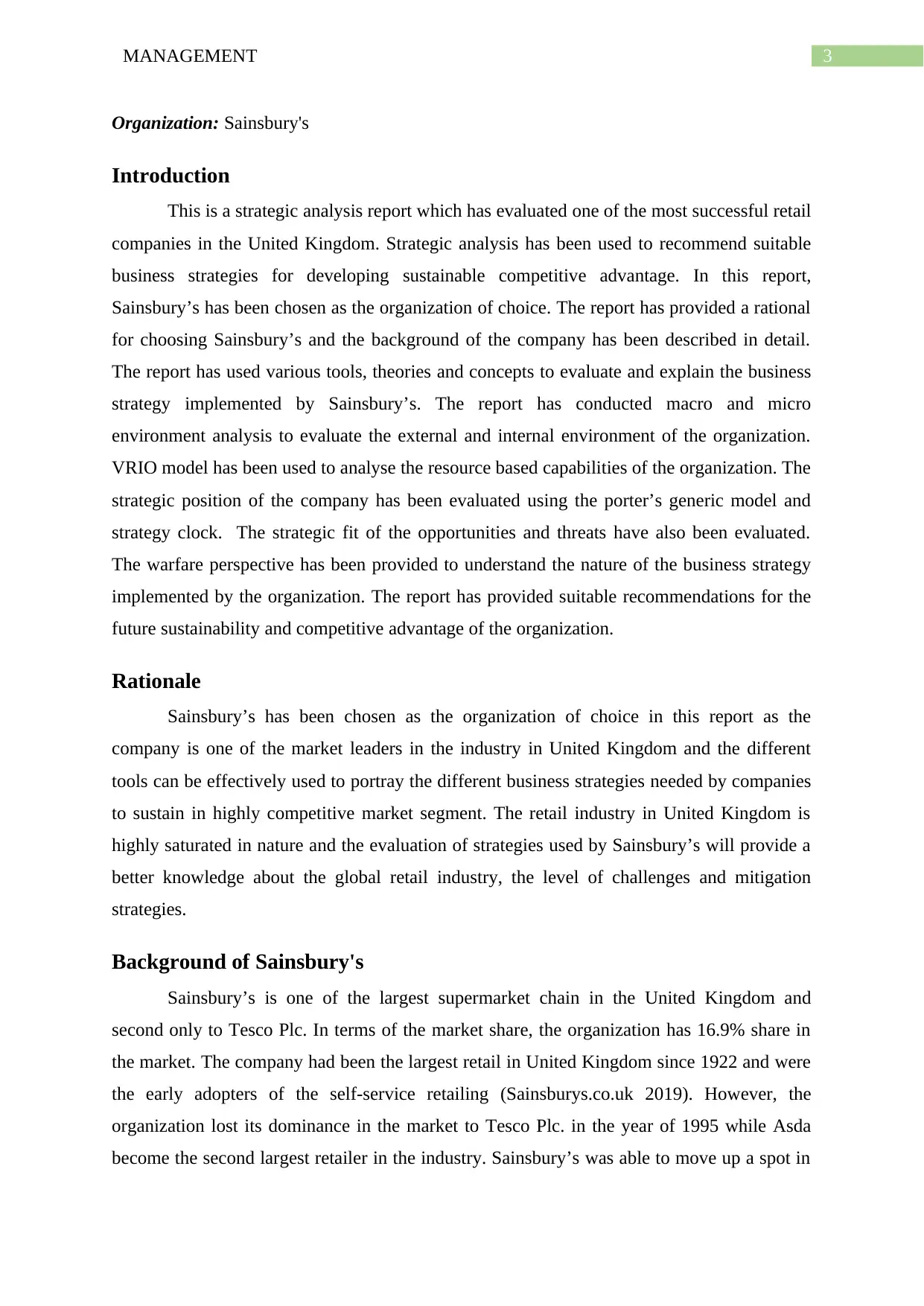
3MANAGEMENT
Organization: Sainsbury's
Introduction
This is a strategic analysis report which has evaluated one of the most successful retail
companies in the United Kingdom. Strategic analysis has been used to recommend suitable
business strategies for developing sustainable competitive advantage. In this report,
Sainsbury’s has been chosen as the organization of choice. The report has provided a rational
for choosing Sainsbury’s and the background of the company has been described in detail.
The report has used various tools, theories and concepts to evaluate and explain the business
strategy implemented by Sainsbury’s. The report has conducted macro and micro
environment analysis to evaluate the external and internal environment of the organization.
VRIO model has been used to analyse the resource based capabilities of the organization. The
strategic position of the company has been evaluated using the porter’s generic model and
strategy clock. The strategic fit of the opportunities and threats have also been evaluated.
The warfare perspective has been provided to understand the nature of the business strategy
implemented by the organization. The report has provided suitable recommendations for the
future sustainability and competitive advantage of the organization.
Rationale
Sainsbury’s has been chosen as the organization of choice in this report as the
company is one of the market leaders in the industry in United Kingdom and the different
tools can be effectively used to portray the different business strategies needed by companies
to sustain in highly competitive market segment. The retail industry in United Kingdom is
highly saturated in nature and the evaluation of strategies used by Sainsbury’s will provide a
better knowledge about the global retail industry, the level of challenges and mitigation
strategies.
Background of Sainsbury's
Sainsbury’s is one of the largest supermarket chain in the United Kingdom and
second only to Tesco Plc. In terms of the market share, the organization has 16.9% share in
the market. The company had been the largest retail in United Kingdom since 1922 and were
the early adopters of the self-service retailing (Sainsburys.co.uk 2019). However, the
organization lost its dominance in the market to Tesco Plc. in the year of 1995 while Asda
become the second largest retailer in the industry. Sainsbury’s was able to move up a spot in
Organization: Sainsbury's
Introduction
This is a strategic analysis report which has evaluated one of the most successful retail
companies in the United Kingdom. Strategic analysis has been used to recommend suitable
business strategies for developing sustainable competitive advantage. In this report,
Sainsbury’s has been chosen as the organization of choice. The report has provided a rational
for choosing Sainsbury’s and the background of the company has been described in detail.
The report has used various tools, theories and concepts to evaluate and explain the business
strategy implemented by Sainsbury’s. The report has conducted macro and micro
environment analysis to evaluate the external and internal environment of the organization.
VRIO model has been used to analyse the resource based capabilities of the organization. The
strategic position of the company has been evaluated using the porter’s generic model and
strategy clock. The strategic fit of the opportunities and threats have also been evaluated.
The warfare perspective has been provided to understand the nature of the business strategy
implemented by the organization. The report has provided suitable recommendations for the
future sustainability and competitive advantage of the organization.
Rationale
Sainsbury’s has been chosen as the organization of choice in this report as the
company is one of the market leaders in the industry in United Kingdom and the different
tools can be effectively used to portray the different business strategies needed by companies
to sustain in highly competitive market segment. The retail industry in United Kingdom is
highly saturated in nature and the evaluation of strategies used by Sainsbury’s will provide a
better knowledge about the global retail industry, the level of challenges and mitigation
strategies.
Background of Sainsbury's
Sainsbury’s is one of the largest supermarket chain in the United Kingdom and
second only to Tesco Plc. In terms of the market share, the organization has 16.9% share in
the market. The company had been the largest retail in United Kingdom since 1922 and were
the early adopters of the self-service retailing (Sainsburys.co.uk 2019). However, the
organization lost its dominance in the market to Tesco Plc. in the year of 1995 while Asda
become the second largest retailer in the industry. Sainsbury’s was able to move up a spot in
Paraphrase This Document
Need a fresh take? Get an instant paraphrase of this document with our AI Paraphraser
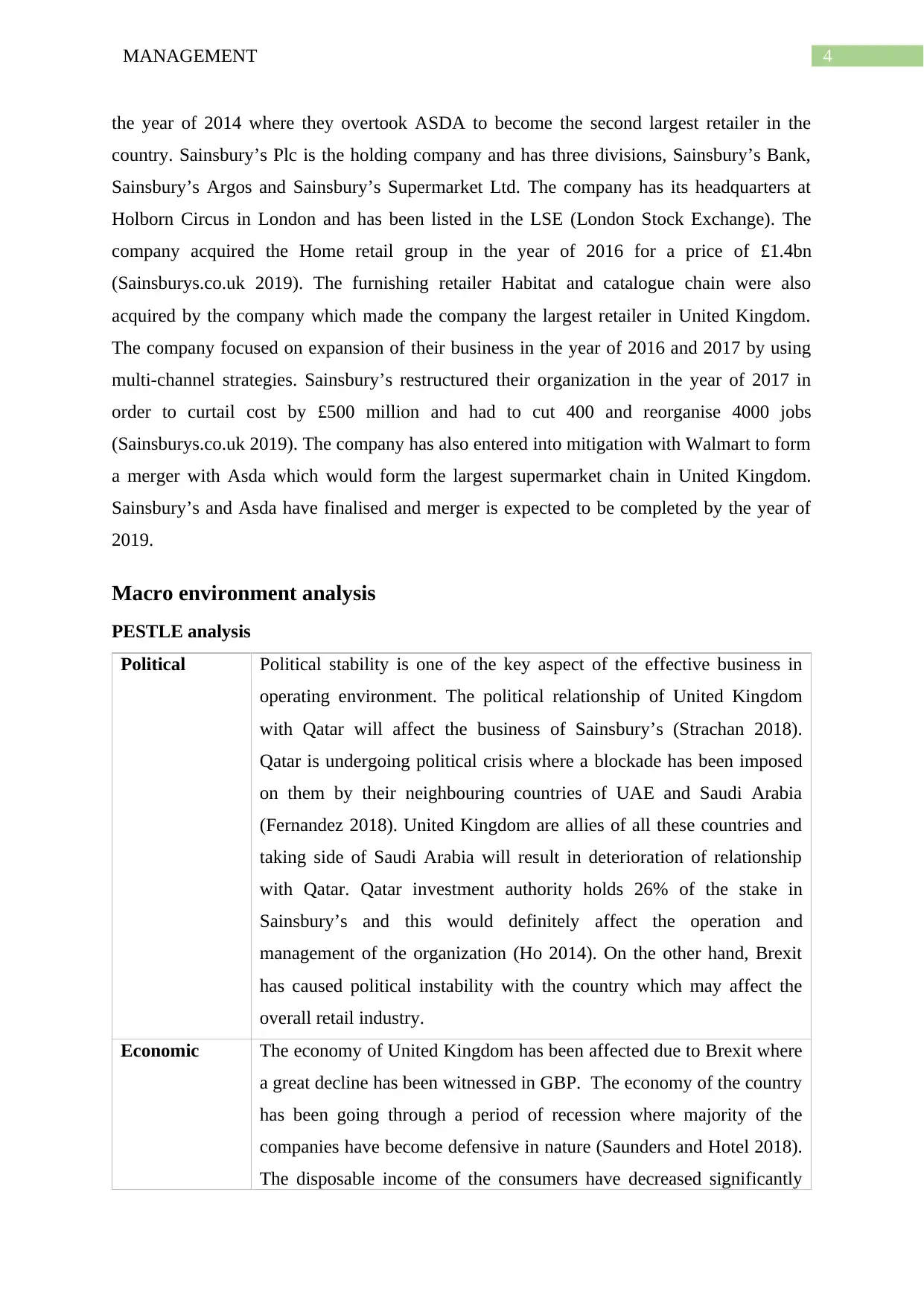
4MANAGEMENT
the year of 2014 where they overtook ASDA to become the second largest retailer in the
country. Sainsbury’s Plc is the holding company and has three divisions, Sainsbury’s Bank,
Sainsbury’s Argos and Sainsbury’s Supermarket Ltd. The company has its headquarters at
Holborn Circus in London and has been listed in the LSE (London Stock Exchange). The
company acquired the Home retail group in the year of 2016 for a price of £1.4bn
(Sainsburys.co.uk 2019). The furnishing retailer Habitat and catalogue chain were also
acquired by the company which made the company the largest retailer in United Kingdom.
The company focused on expansion of their business in the year of 2016 and 2017 by using
multi-channel strategies. Sainsbury’s restructured their organization in the year of 2017 in
order to curtail cost by £500 million and had to cut 400 and reorganise 4000 jobs
(Sainsburys.co.uk 2019). The company has also entered into mitigation with Walmart to form
a merger with Asda which would form the largest supermarket chain in United Kingdom.
Sainsbury’s and Asda have finalised and merger is expected to be completed by the year of
2019.
Macro environment analysis
PESTLE analysis
Political Political stability is one of the key aspect of the effective business in
operating environment. The political relationship of United Kingdom
with Qatar will affect the business of Sainsbury’s (Strachan 2018).
Qatar is undergoing political crisis where a blockade has been imposed
on them by their neighbouring countries of UAE and Saudi Arabia
(Fernandez 2018). United Kingdom are allies of all these countries and
taking side of Saudi Arabia will result in deterioration of relationship
with Qatar. Qatar investment authority holds 26% of the stake in
Sainsbury’s and this would definitely affect the operation and
management of the organization (Ho 2014). On the other hand, Brexit
has caused political instability with the country which may affect the
overall retail industry.
Economic The economy of United Kingdom has been affected due to Brexit where
a great decline has been witnessed in GBP. The economy of the country
has been going through a period of recession where majority of the
companies have become defensive in nature (Saunders and Hotel 2018).
The disposable income of the consumers have decreased significantly
the year of 2014 where they overtook ASDA to become the second largest retailer in the
country. Sainsbury’s Plc is the holding company and has three divisions, Sainsbury’s Bank,
Sainsbury’s Argos and Sainsbury’s Supermarket Ltd. The company has its headquarters at
Holborn Circus in London and has been listed in the LSE (London Stock Exchange). The
company acquired the Home retail group in the year of 2016 for a price of £1.4bn
(Sainsburys.co.uk 2019). The furnishing retailer Habitat and catalogue chain were also
acquired by the company which made the company the largest retailer in United Kingdom.
The company focused on expansion of their business in the year of 2016 and 2017 by using
multi-channel strategies. Sainsbury’s restructured their organization in the year of 2017 in
order to curtail cost by £500 million and had to cut 400 and reorganise 4000 jobs
(Sainsburys.co.uk 2019). The company has also entered into mitigation with Walmart to form
a merger with Asda which would form the largest supermarket chain in United Kingdom.
Sainsbury’s and Asda have finalised and merger is expected to be completed by the year of
2019.
Macro environment analysis
PESTLE analysis
Political Political stability is one of the key aspect of the effective business in
operating environment. The political relationship of United Kingdom
with Qatar will affect the business of Sainsbury’s (Strachan 2018).
Qatar is undergoing political crisis where a blockade has been imposed
on them by their neighbouring countries of UAE and Saudi Arabia
(Fernandez 2018). United Kingdom are allies of all these countries and
taking side of Saudi Arabia will result in deterioration of relationship
with Qatar. Qatar investment authority holds 26% of the stake in
Sainsbury’s and this would definitely affect the operation and
management of the organization (Ho 2014). On the other hand, Brexit
has caused political instability with the country which may affect the
overall retail industry.
Economic The economy of United Kingdom has been affected due to Brexit where
a great decline has been witnessed in GBP. The economy of the country
has been going through a period of recession where majority of the
companies have become defensive in nature (Saunders and Hotel 2018).
The disposable income of the consumers have decreased significantly
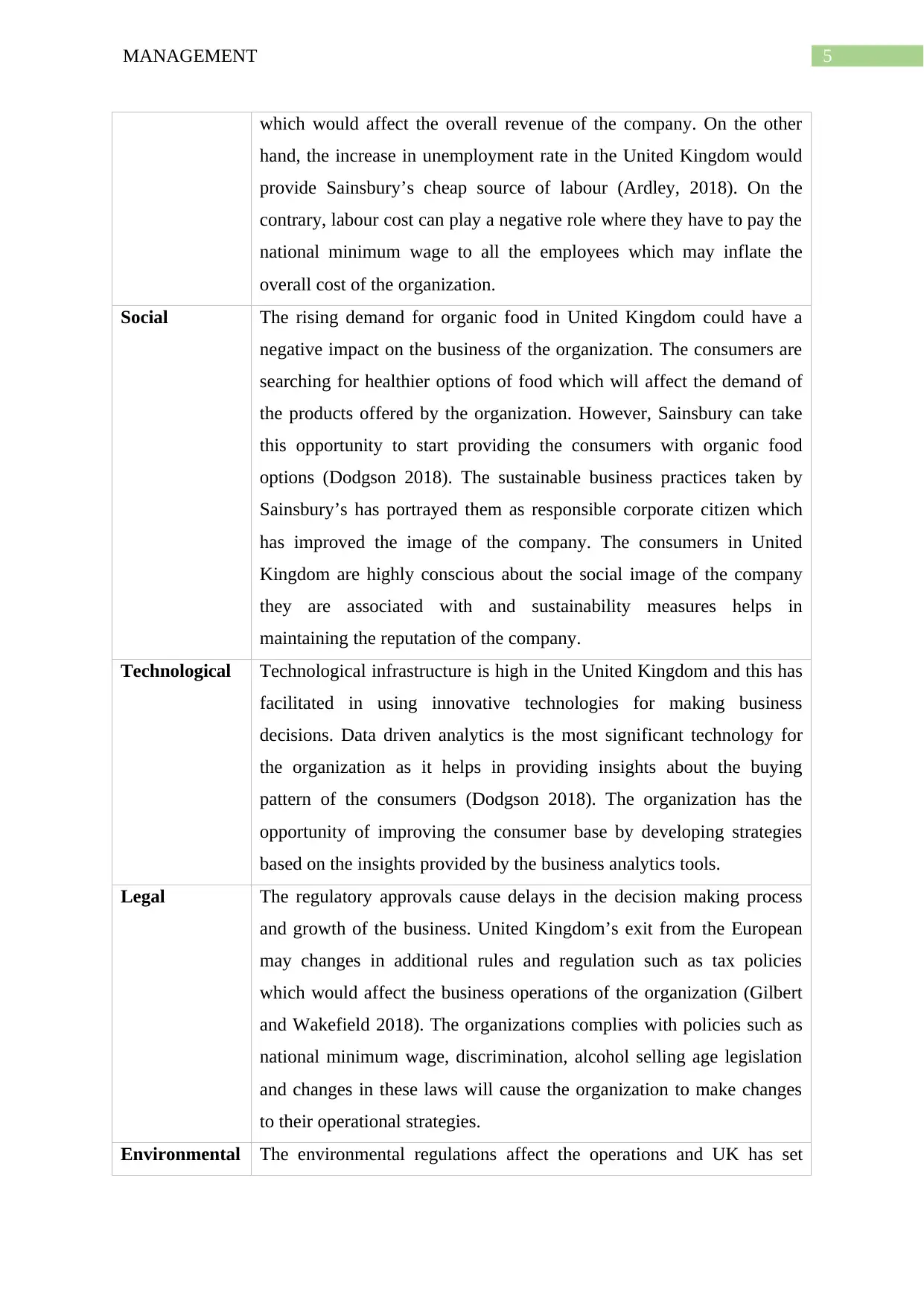
5MANAGEMENT
which would affect the overall revenue of the company. On the other
hand, the increase in unemployment rate in the United Kingdom would
provide Sainsbury’s cheap source of labour (Ardley, 2018). On the
contrary, labour cost can play a negative role where they have to pay the
national minimum wage to all the employees which may inflate the
overall cost of the organization.
Social The rising demand for organic food in United Kingdom could have a
negative impact on the business of the organization. The consumers are
searching for healthier options of food which will affect the demand of
the products offered by the organization. However, Sainsbury can take
this opportunity to start providing the consumers with organic food
options (Dodgson 2018). The sustainable business practices taken by
Sainsbury’s has portrayed them as responsible corporate citizen which
has improved the image of the company. The consumers in United
Kingdom are highly conscious about the social image of the company
they are associated with and sustainability measures helps in
maintaining the reputation of the company.
Technological Technological infrastructure is high in the United Kingdom and this has
facilitated in using innovative technologies for making business
decisions. Data driven analytics is the most significant technology for
the organization as it helps in providing insights about the buying
pattern of the consumers (Dodgson 2018). The organization has the
opportunity of improving the consumer base by developing strategies
based on the insights provided by the business analytics tools.
Legal The regulatory approvals cause delays in the decision making process
and growth of the business. United Kingdom’s exit from the European
may changes in additional rules and regulation such as tax policies
which would affect the business operations of the organization (Gilbert
and Wakefield 2018). The organizations complies with policies such as
national minimum wage, discrimination, alcohol selling age legislation
and changes in these laws will cause the organization to make changes
to their operational strategies.
Environmental The environmental regulations affect the operations and UK has set
which would affect the overall revenue of the company. On the other
hand, the increase in unemployment rate in the United Kingdom would
provide Sainsbury’s cheap source of labour (Ardley, 2018). On the
contrary, labour cost can play a negative role where they have to pay the
national minimum wage to all the employees which may inflate the
overall cost of the organization.
Social The rising demand for organic food in United Kingdom could have a
negative impact on the business of the organization. The consumers are
searching for healthier options of food which will affect the demand of
the products offered by the organization. However, Sainsbury can take
this opportunity to start providing the consumers with organic food
options (Dodgson 2018). The sustainable business practices taken by
Sainsbury’s has portrayed them as responsible corporate citizen which
has improved the image of the company. The consumers in United
Kingdom are highly conscious about the social image of the company
they are associated with and sustainability measures helps in
maintaining the reputation of the company.
Technological Technological infrastructure is high in the United Kingdom and this has
facilitated in using innovative technologies for making business
decisions. Data driven analytics is the most significant technology for
the organization as it helps in providing insights about the buying
pattern of the consumers (Dodgson 2018). The organization has the
opportunity of improving the consumer base by developing strategies
based on the insights provided by the business analytics tools.
Legal The regulatory approvals cause delays in the decision making process
and growth of the business. United Kingdom’s exit from the European
may changes in additional rules and regulation such as tax policies
which would affect the business operations of the organization (Gilbert
and Wakefield 2018). The organizations complies with policies such as
national minimum wage, discrimination, alcohol selling age legislation
and changes in these laws will cause the organization to make changes
to their operational strategies.
Environmental The environmental regulations affect the operations and UK has set
⊘ This is a preview!⊘
Do you want full access?
Subscribe today to unlock all pages.

Trusted by 1+ million students worldwide
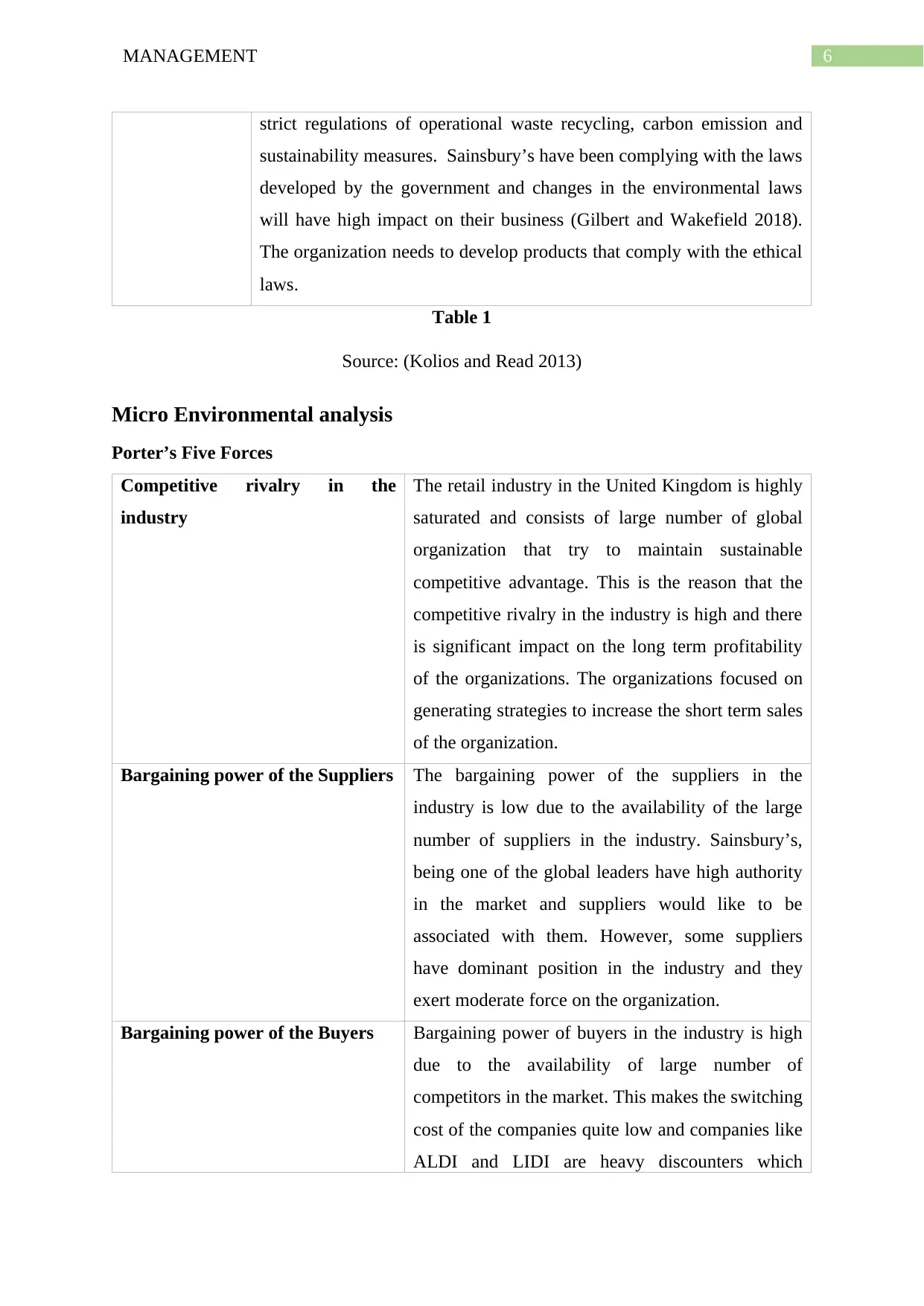
6MANAGEMENT
strict regulations of operational waste recycling, carbon emission and
sustainability measures. Sainsbury’s have been complying with the laws
developed by the government and changes in the environmental laws
will have high impact on their business (Gilbert and Wakefield 2018).
The organization needs to develop products that comply with the ethical
laws.
Table 1
Source: (Kolios and Read 2013)
Micro Environmental analysis
Porter’s Five Forces
Competitive rivalry in the
industry
The retail industry in the United Kingdom is highly
saturated and consists of large number of global
organization that try to maintain sustainable
competitive advantage. This is the reason that the
competitive rivalry in the industry is high and there
is significant impact on the long term profitability
of the organizations. The organizations focused on
generating strategies to increase the short term sales
of the organization.
Bargaining power of the Suppliers The bargaining power of the suppliers in the
industry is low due to the availability of the large
number of suppliers in the industry. Sainsbury’s,
being one of the global leaders have high authority
in the market and suppliers would like to be
associated with them. However, some suppliers
have dominant position in the industry and they
exert moderate force on the organization.
Bargaining power of the Buyers Bargaining power of buyers in the industry is high
due to the availability of large number of
competitors in the market. This makes the switching
cost of the companies quite low and companies like
ALDI and LIDI are heavy discounters which
strict regulations of operational waste recycling, carbon emission and
sustainability measures. Sainsbury’s have been complying with the laws
developed by the government and changes in the environmental laws
will have high impact on their business (Gilbert and Wakefield 2018).
The organization needs to develop products that comply with the ethical
laws.
Table 1
Source: (Kolios and Read 2013)
Micro Environmental analysis
Porter’s Five Forces
Competitive rivalry in the
industry
The retail industry in the United Kingdom is highly
saturated and consists of large number of global
organization that try to maintain sustainable
competitive advantage. This is the reason that the
competitive rivalry in the industry is high and there
is significant impact on the long term profitability
of the organizations. The organizations focused on
generating strategies to increase the short term sales
of the organization.
Bargaining power of the Suppliers The bargaining power of the suppliers in the
industry is low due to the availability of the large
number of suppliers in the industry. Sainsbury’s,
being one of the global leaders have high authority
in the market and suppliers would like to be
associated with them. However, some suppliers
have dominant position in the industry and they
exert moderate force on the organization.
Bargaining power of the Buyers Bargaining power of buyers in the industry is high
due to the availability of large number of
competitors in the market. This makes the switching
cost of the companies quite low and companies like
ALDI and LIDI are heavy discounters which
Paraphrase This Document
Need a fresh take? Get an instant paraphrase of this document with our AI Paraphraser
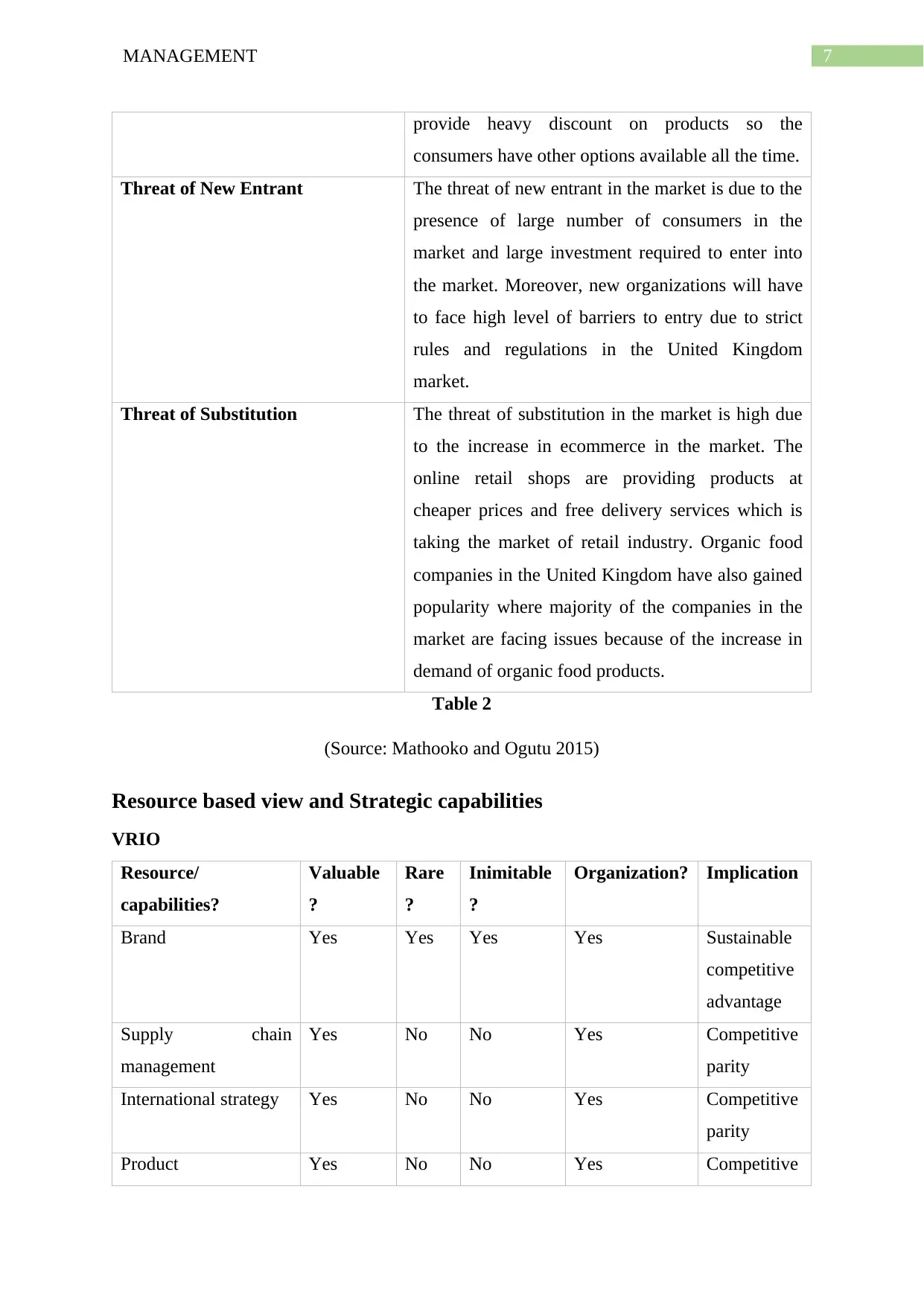
7MANAGEMENT
provide heavy discount on products so the
consumers have other options available all the time.
Threat of New Entrant The threat of new entrant in the market is due to the
presence of large number of consumers in the
market and large investment required to enter into
the market. Moreover, new organizations will have
to face high level of barriers to entry due to strict
rules and regulations in the United Kingdom
market.
Threat of Substitution The threat of substitution in the market is high due
to the increase in ecommerce in the market. The
online retail shops are providing products at
cheaper prices and free delivery services which is
taking the market of retail industry. Organic food
companies in the United Kingdom have also gained
popularity where majority of the companies in the
market are facing issues because of the increase in
demand of organic food products.
Table 2
(Source: Mathooko and Ogutu 2015)
Resource based view and Strategic capabilities
VRIO
Resource/
capabilities?
Valuable
?
Rare
?
Inimitable
?
Organization? Implication
Brand Yes Yes Yes Yes Sustainable
competitive
advantage
Supply chain
management
Yes No No Yes Competitive
parity
International strategy Yes No No Yes Competitive
parity
Product Yes No No Yes Competitive
provide heavy discount on products so the
consumers have other options available all the time.
Threat of New Entrant The threat of new entrant in the market is due to the
presence of large number of consumers in the
market and large investment required to enter into
the market. Moreover, new organizations will have
to face high level of barriers to entry due to strict
rules and regulations in the United Kingdom
market.
Threat of Substitution The threat of substitution in the market is high due
to the increase in ecommerce in the market. The
online retail shops are providing products at
cheaper prices and free delivery services which is
taking the market of retail industry. Organic food
companies in the United Kingdom have also gained
popularity where majority of the companies in the
market are facing issues because of the increase in
demand of organic food products.
Table 2
(Source: Mathooko and Ogutu 2015)
Resource based view and Strategic capabilities
VRIO
Resource/
capabilities?
Valuable
?
Rare
?
Inimitable
?
Organization? Implication
Brand Yes Yes Yes Yes Sustainable
competitive
advantage
Supply chain
management
Yes No No Yes Competitive
parity
International strategy Yes No No Yes Competitive
parity
Product Yes No No Yes Competitive
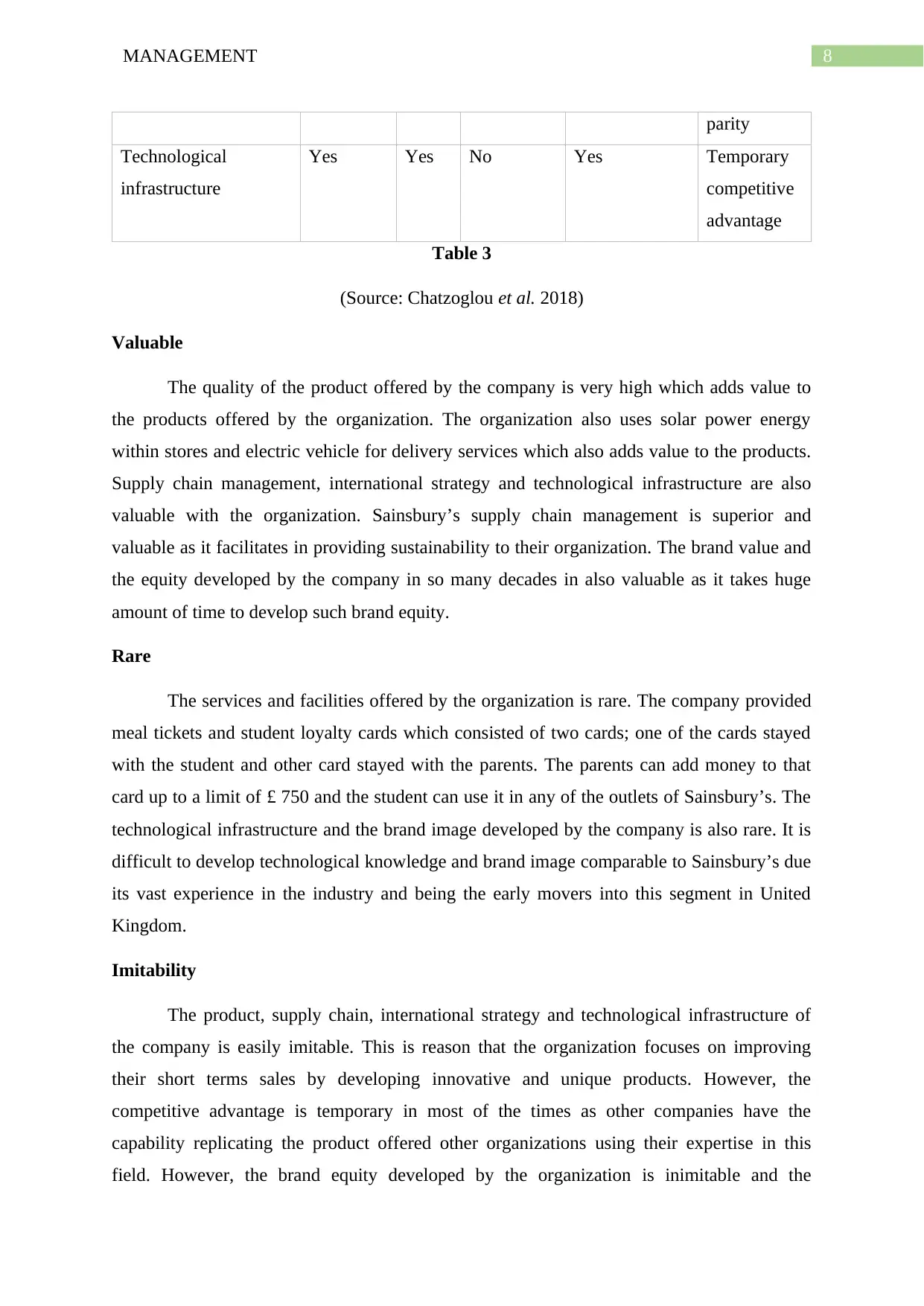
8MANAGEMENT
parity
Technological
infrastructure
Yes Yes No Yes Temporary
competitive
advantage
Table 3
(Source: Chatzoglou et al. 2018)
Valuable
The quality of the product offered by the company is very high which adds value to
the products offered by the organization. The organization also uses solar power energy
within stores and electric vehicle for delivery services which also adds value to the products.
Supply chain management, international strategy and technological infrastructure are also
valuable with the organization. Sainsbury’s supply chain management is superior and
valuable as it facilitates in providing sustainability to their organization. The brand value and
the equity developed by the company in so many decades in also valuable as it takes huge
amount of time to develop such brand equity.
Rare
The services and facilities offered by the organization is rare. The company provided
meal tickets and student loyalty cards which consisted of two cards; one of the cards stayed
with the student and other card stayed with the parents. The parents can add money to that
card up to a limit of £ 750 and the student can use it in any of the outlets of Sainsbury’s. The
technological infrastructure and the brand image developed by the company is also rare. It is
difficult to develop technological knowledge and brand image comparable to Sainsbury’s due
its vast experience in the industry and being the early movers into this segment in United
Kingdom.
Imitability
The product, supply chain, international strategy and technological infrastructure of
the company is easily imitable. This is reason that the organization focuses on improving
their short terms sales by developing innovative and unique products. However, the
competitive advantage is temporary in most of the times as other companies have the
capability replicating the product offered other organizations using their expertise in this
field. However, the brand equity developed by the organization is inimitable and the
parity
Technological
infrastructure
Yes Yes No Yes Temporary
competitive
advantage
Table 3
(Source: Chatzoglou et al. 2018)
Valuable
The quality of the product offered by the company is very high which adds value to
the products offered by the organization. The organization also uses solar power energy
within stores and electric vehicle for delivery services which also adds value to the products.
Supply chain management, international strategy and technological infrastructure are also
valuable with the organization. Sainsbury’s supply chain management is superior and
valuable as it facilitates in providing sustainability to their organization. The brand value and
the equity developed by the company in so many decades in also valuable as it takes huge
amount of time to develop such brand equity.
Rare
The services and facilities offered by the organization is rare. The company provided
meal tickets and student loyalty cards which consisted of two cards; one of the cards stayed
with the student and other card stayed with the parents. The parents can add money to that
card up to a limit of £ 750 and the student can use it in any of the outlets of Sainsbury’s. The
technological infrastructure and the brand image developed by the company is also rare. It is
difficult to develop technological knowledge and brand image comparable to Sainsbury’s due
its vast experience in the industry and being the early movers into this segment in United
Kingdom.
Imitability
The product, supply chain, international strategy and technological infrastructure of
the company is easily imitable. This is reason that the organization focuses on improving
their short terms sales by developing innovative and unique products. However, the
competitive advantage is temporary in most of the times as other companies have the
capability replicating the product offered other organizations using their expertise in this
field. However, the brand equity developed by the organization is inimitable and the
⊘ This is a preview!⊘
Do you want full access?
Subscribe today to unlock all pages.

Trusted by 1+ million students worldwide
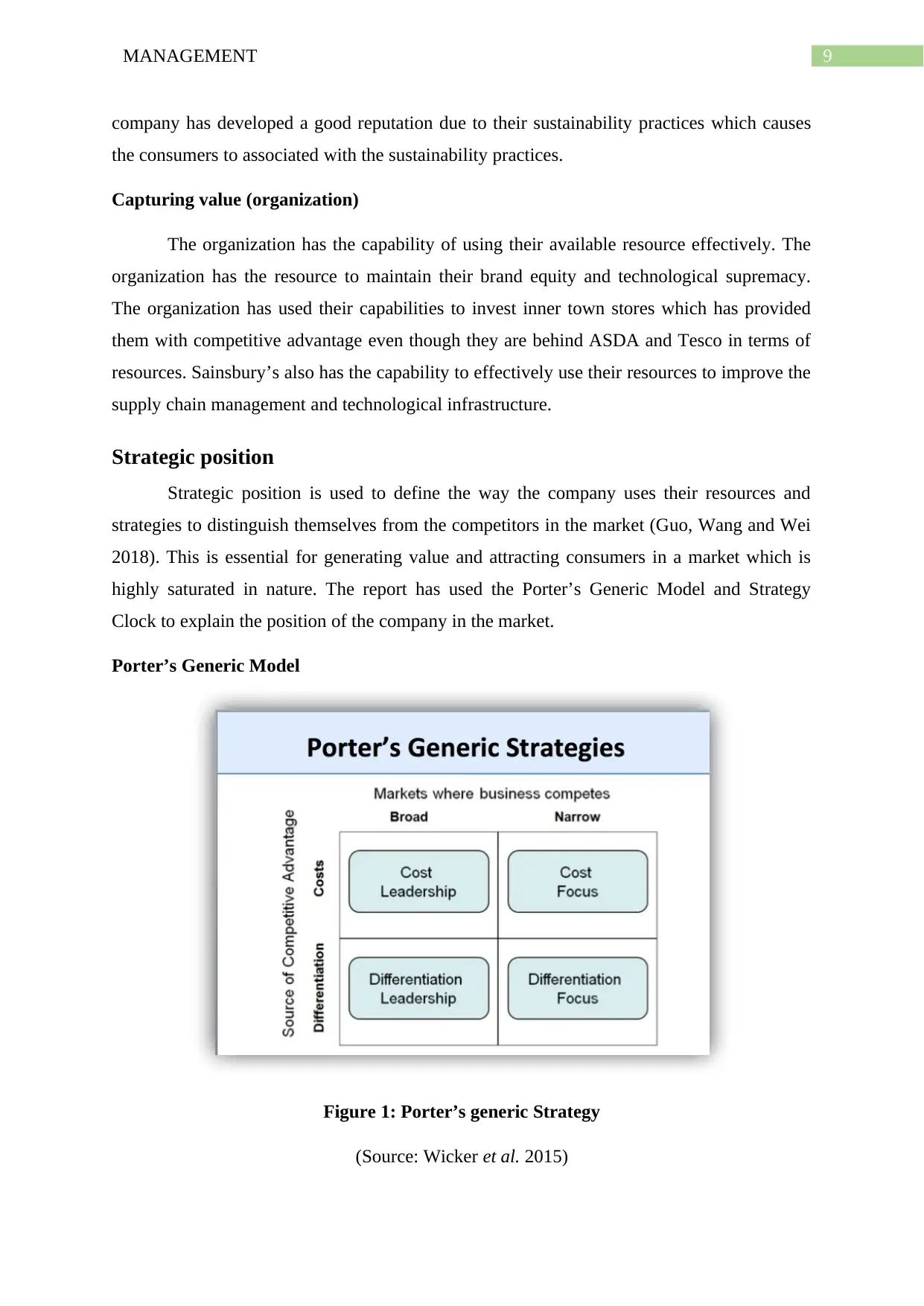
9MANAGEMENT
company has developed a good reputation due to their sustainability practices which causes
the consumers to associated with the sustainability practices.
Capturing value (organization)
The organization has the capability of using their available resource effectively. The
organization has the resource to maintain their brand equity and technological supremacy.
The organization has used their capabilities to invest inner town stores which has provided
them with competitive advantage even though they are behind ASDA and Tesco in terms of
resources. Sainsbury’s also has the capability to effectively use their resources to improve the
supply chain management and technological infrastructure.
Strategic position
Strategic position is used to define the way the company uses their resources and
strategies to distinguish themselves from the competitors in the market (Guo, Wang and Wei
2018). This is essential for generating value and attracting consumers in a market which is
highly saturated in nature. The report has used the Porter’s Generic Model and Strategy
Clock to explain the position of the company in the market.
Porter’s Generic Model
Figure 1: Porter’s generic Strategy
(Source: Wicker et al. 2015)
company has developed a good reputation due to their sustainability practices which causes
the consumers to associated with the sustainability practices.
Capturing value (organization)
The organization has the capability of using their available resource effectively. The
organization has the resource to maintain their brand equity and technological supremacy.
The organization has used their capabilities to invest inner town stores which has provided
them with competitive advantage even though they are behind ASDA and Tesco in terms of
resources. Sainsbury’s also has the capability to effectively use their resources to improve the
supply chain management and technological infrastructure.
Strategic position
Strategic position is used to define the way the company uses their resources and
strategies to distinguish themselves from the competitors in the market (Guo, Wang and Wei
2018). This is essential for generating value and attracting consumers in a market which is
highly saturated in nature. The report has used the Porter’s Generic Model and Strategy
Clock to explain the position of the company in the market.
Porter’s Generic Model
Figure 1: Porter’s generic Strategy
(Source: Wicker et al. 2015)
Paraphrase This Document
Need a fresh take? Get an instant paraphrase of this document with our AI Paraphraser
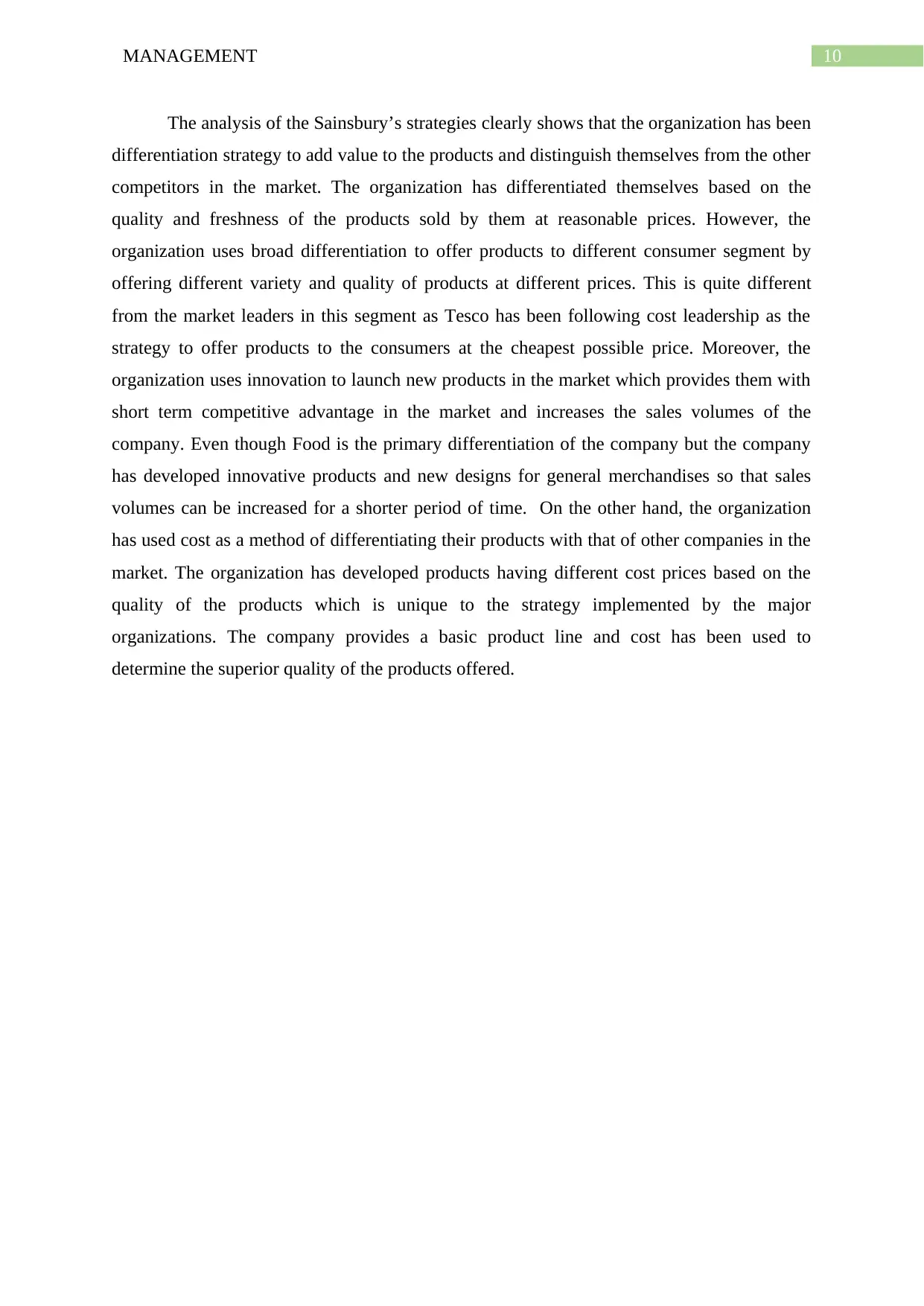
10MANAGEMENT
The analysis of the Sainsbury’s strategies clearly shows that the organization has been
differentiation strategy to add value to the products and distinguish themselves from the other
competitors in the market. The organization has differentiated themselves based on the
quality and freshness of the products sold by them at reasonable prices. However, the
organization uses broad differentiation to offer products to different consumer segment by
offering different variety and quality of products at different prices. This is quite different
from the market leaders in this segment as Tesco has been following cost leadership as the
strategy to offer products to the consumers at the cheapest possible price. Moreover, the
organization uses innovation to launch new products in the market which provides them with
short term competitive advantage in the market and increases the sales volumes of the
company. Even though Food is the primary differentiation of the company but the company
has developed innovative products and new designs for general merchandises so that sales
volumes can be increased for a shorter period of time. On the other hand, the organization
has used cost as a method of differentiating their products with that of other companies in the
market. The organization has developed products having different cost prices based on the
quality of the products which is unique to the strategy implemented by the major
organizations. The company provides a basic product line and cost has been used to
determine the superior quality of the products offered.
The analysis of the Sainsbury’s strategies clearly shows that the organization has been
differentiation strategy to add value to the products and distinguish themselves from the other
competitors in the market. The organization has differentiated themselves based on the
quality and freshness of the products sold by them at reasonable prices. However, the
organization uses broad differentiation to offer products to different consumer segment by
offering different variety and quality of products at different prices. This is quite different
from the market leaders in this segment as Tesco has been following cost leadership as the
strategy to offer products to the consumers at the cheapest possible price. Moreover, the
organization uses innovation to launch new products in the market which provides them with
short term competitive advantage in the market and increases the sales volumes of the
company. Even though Food is the primary differentiation of the company but the company
has developed innovative products and new designs for general merchandises so that sales
volumes can be increased for a shorter period of time. On the other hand, the organization
has used cost as a method of differentiating their products with that of other companies in the
market. The organization has developed products having different cost prices based on the
quality of the products which is unique to the strategy implemented by the major
organizations. The company provides a basic product line and cost has been used to
determine the superior quality of the products offered.
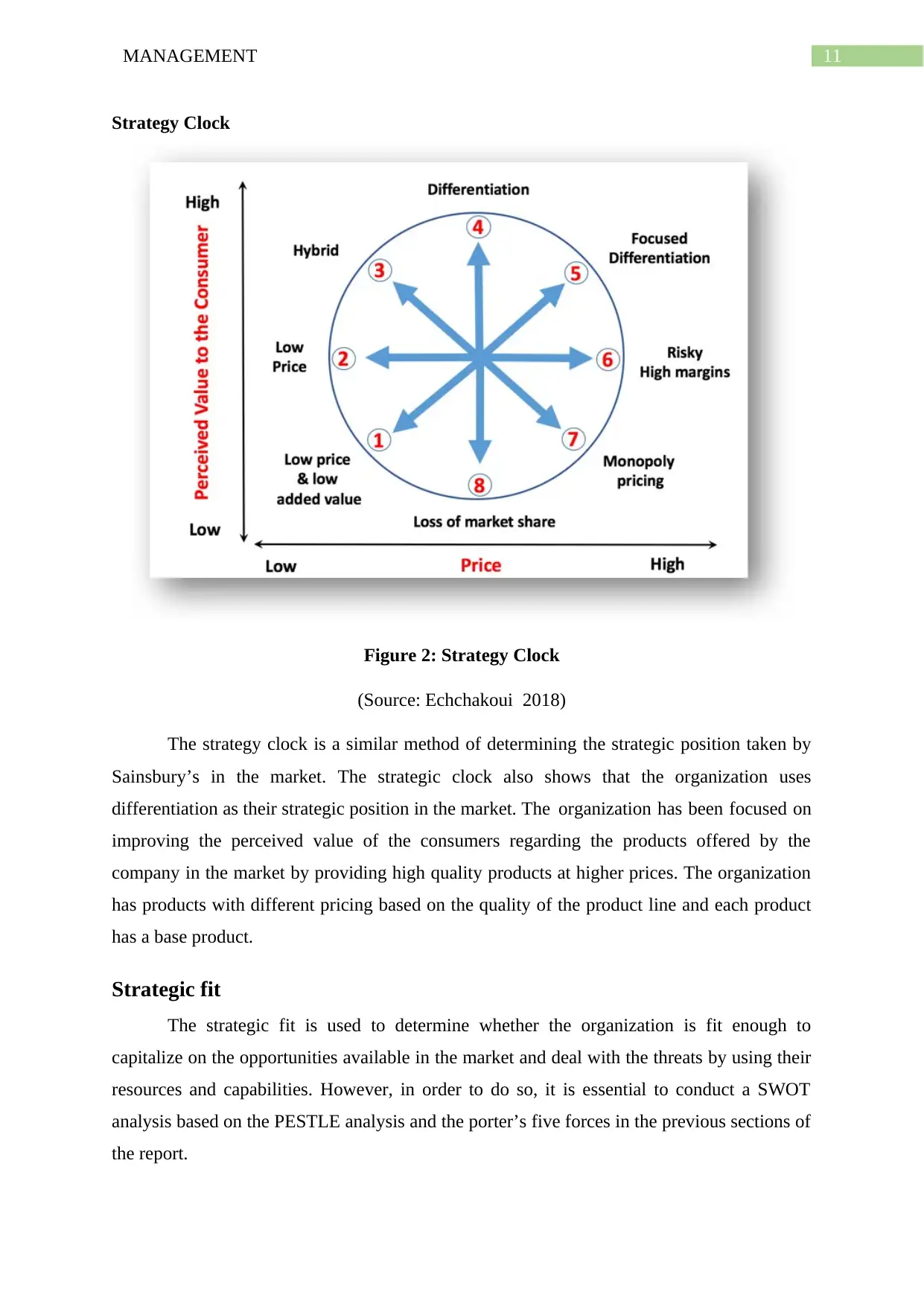
11MANAGEMENT
Strategy Clock
Figure 2: Strategy Clock
(Source: Echchakoui 2018)
The strategy clock is a similar method of determining the strategic position taken by
Sainsbury’s in the market. The strategic clock also shows that the organization uses
differentiation as their strategic position in the market. The organization has been focused on
improving the perceived value of the consumers regarding the products offered by the
company in the market by providing high quality products at higher prices. The organization
has products with different pricing based on the quality of the product line and each product
has a base product.
Strategic fit
The strategic fit is used to determine whether the organization is fit enough to
capitalize on the opportunities available in the market and deal with the threats by using their
resources and capabilities. However, in order to do so, it is essential to conduct a SWOT
analysis based on the PESTLE analysis and the porter’s five forces in the previous sections of
the report.
Strategy Clock
Figure 2: Strategy Clock
(Source: Echchakoui 2018)
The strategy clock is a similar method of determining the strategic position taken by
Sainsbury’s in the market. The strategic clock also shows that the organization uses
differentiation as their strategic position in the market. The organization has been focused on
improving the perceived value of the consumers regarding the products offered by the
company in the market by providing high quality products at higher prices. The organization
has products with different pricing based on the quality of the product line and each product
has a base product.
Strategic fit
The strategic fit is used to determine whether the organization is fit enough to
capitalize on the opportunities available in the market and deal with the threats by using their
resources and capabilities. However, in order to do so, it is essential to conduct a SWOT
analysis based on the PESTLE analysis and the porter’s five forces in the previous sections of
the report.
⊘ This is a preview!⊘
Do you want full access?
Subscribe today to unlock all pages.

Trusted by 1+ million students worldwide
1 out of 19
Related Documents
Your All-in-One AI-Powered Toolkit for Academic Success.
+13062052269
info@desklib.com
Available 24*7 on WhatsApp / Email
![[object Object]](/_next/static/media/star-bottom.7253800d.svg)
Unlock your academic potential
Copyright © 2020–2025 A2Z Services. All Rights Reserved. Developed and managed by ZUCOL.




